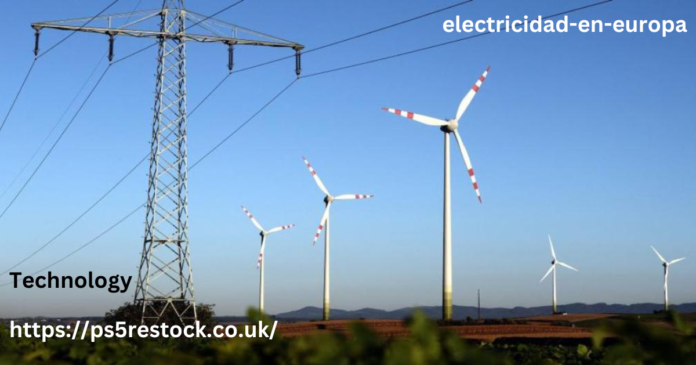Introduction to Electricity in Europe
Electricity is the lifeblood of modern travel, powering everything from your smartphone to those cozy hotel room lights. Yet when you set foot in Europe, you’ll quickly discover that not all electrical experiences are created equal. Different countries feature unique outlets and voltages, which can pose challenges for even the most seasoned travelers. Whether you’re planning an adventurous road trip through Italy or a cultural escape to France, understanding how electricity works across this diverse continent is crucial. Not only will it help https://finanzasdomesticas.com/electricidad-en-europa/ the way. Join us as we explore the fascinating world of electricity in Europe—your guide to navigating electric currents while enjoying every moment of your journey!
Understanding the different types of electrical outlets and voltages in Europe

Europe features a variety of electrical outlets and voltages, which can be confusing for travelers. The standard voltage across most countries is 230 volts with a frequency of 50 Hz. However, some regions may have slight variations.
There are several types of plugs used in Europe, the most common being Type C and Type F. Type C has two round pins and is widely used in various European nations. Meanwhile, Type F includes additional grounding clips for safety.
Always check the specific requirements for your destination country before plugging in devices. Compatibility issues can lead to malfunctioning equipment or even damage to your electronics if you’re not careful.
Investing in a quality universal adapter will help navigate these differences effectively. Understanding this aspect can make traveling smoother without any unexpected electrical surprises along the way.
The pros and cons of using adapters vs. converters for electronic devices
When traveling in Europe, you’ll quickly discover the need for adapters and converters. Both serve essential functions, but they cater to different needs.
Adapters are straightforward devices that allow you to plug your electronics into foreign outlets. They’re lightweight and typically cheaper than converters. However, an adapter does not change voltage levels; it merely alters the shape of the plug. This can lead to issues if your device is not compatible with European voltages.
On the other hand, converters modify both the shape and voltage of electrical flow. They ensure that your devices function safely without damage from a higher or lower voltage supply. That said, they tend to be bulkier and pricier than simple adapters.
Choosing between them depends on what gadgets you’re bringing along and their power requirements. Knowing your equipment’s specifications will guide you in making the right choice before embarking on your journey across Europe.
Tips for saving money on electricity while traveling in Europe

Traveling through Europe offers a great opportunity to explore, but it can also strain your budget. A few simple strategies can help you save on electricidad costs during your journey.
First, be mindful of how often you use chargers and devices. Unplugging them when not in use can prevent unnecessary energy consumption.
Consider using local public transport instead of taxis or rideshares that require charging stations for electric vehicles. This choice reduces your carbon footprint while keeping expenses down.
Opt for accommodations that emphasize sustainability. Many hotels and hostels now promote energy-saving practices, which often translates to lower electricity rates.
Embrace natural light whenever possible. Open those curtains during the day rather than turning on lights early on, and enjoy the beautiful European scenery as well!
Differences in electricity rates and usage patterns across European countries electricidad
Electricity rates vary significantly across Europe, influenced by factors such as government policies, energy sources, and market competition. For instance, Scandinavian countries often enjoy lower prices due to abundant hydroelectric power.
In contrast, nations like Germany face higher costs attributable to renewable energy investments and taxes aimed at reducing carbon emissions. This can lead to surprise bills for travelers who are not aware of local pricing structures.
Usage patterns also differ widely. In southern European countries, air conditioning drives up demand during the hot summers. Meanwhile, northern regions may see spikes in usage during long winter nights when heating is essential.
Cultural attitudes towards electricity also play a role. Some countries prioritize energy efficiency more than others, impacting how residents manage their consumption habits daily. Understanding these nuances helps travelers navigate their expenses better while exploring the continent.
Sustainable energy initiatives in Europe and how they affect electricity costs

Europe is at the forefront of sustainable energy initiatives. Countries are investing heavily in renewable sources, such as wind, solar, and hydropower.
These investments often lead to lower electricity costs in the long run. As more green energy enters the grid, reliance on fossil fuels decreases. This shift helps stabilize prices and reduces volatility.
However, transitioning to renewables can come with initial expenses. Infrastructure upgrades and technology electricidad implementation require funding. While these upfront costs might raise prices temporarily, they pave the way for a cleaner future.
Sustainable practices also encourage energy efficiency among consumers. With incentives for using less power during peak times or adopting smart home technologies, households can save money while contributing to environmental goals.
As Europe continues this journey towards sustainability, it’s vital for travelers to stay informed about how these changes influence their own electricity usage abroad.
Conclusion: Making informed decisions about electricidad usage during your travels to Europe
Traveling in Europe offers unique experiences, but navigating electricity usage can be a challenge. Understanding the various types of outlets and voltages is crucial for keeping your devices powered. Knowing whether to use an adapter or converter can save you from potential mishaps.
Being conscious of energy consumption electricidad not only helps your wallet but also aligns with Europe’s growing focus on sustainability. Each country has its own rates and patterns, which means that being informed can lead to smarter choices.
As you embark on your journey across this diverse continent, take the time to familiarize yourself with local electrical norms and practices. This awareness will enhance your travel experience while ensuring that you stay connected without unnecessary costs or hassle. Embrace https://finanzasdomesticas.com/electricidad-en-europa/ electricity in Europe—it’s an integral part of making your travels smoother and more enjoyable.
